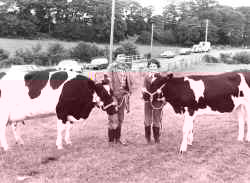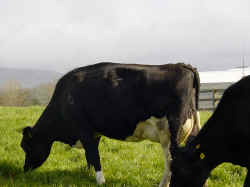|
|
|
Dairy Herd |
|
|
|
|
| Pedigree: All female stock on the farm are registered with the Irish Holstein Friesian Association (IHFA). The first cows were registered in 1961 with the British Friesian Association and many of the present cow families are descended from these. Our policy has always been to breed our own replacement animals for the dairy herd and any excess heifers are sold in-calf. |
|
|
Production: In common with all farmers in the EU our milk production is governed by the quota system. Our current quota is 378,549 litres. Every year we try to purchase or lease additional quota to allow us to increase production. The average yield per cow last year was 8000 litres for a 305 day lactation. Average butterfat was 3.75% and protein 3.25%. Milking times are 6.30am and 4.30pm. Having increased cow yield over the last number of years we now feel this is the optimum level to suit our facilities and system of farming. |
|
|
Breeding: All breeding is done by artificial insemination to holstein sires. Bulls used must combine production with good type. A good udder score is essential and strength is also important. We tend to use well proven sires. As liquid milk suppliers we supply milk all year round, so the calving season is split with 65% of the herd calving in spring and the rest in autumn. The calving interval is 390 days. Our average replacement rate is 15% and we like our heifers to calve around 26 months. |
|
|
Feeding: Our cows spend up to five months indoors in winter when they are fed grass silage and concentrates. For the rest of the year outdoors, their diet consists of grazed grass and a reduced level of concentrates. We expect a yield of 20 litres per cow from grass alone, above that we feed 0.50kgs of concentrate per litre. A 21% protein ration is fed in winter and a 16% protein ration in summer. We usually let the cows out to grass by day in mid March, weather permitting and at the end of April they go out full time. Silage ground is grazed first and is closed from mid April for cutting in early June. The grazing season lasts until the end of October again depending on weather conditions. Concentrates are parlour fed according to yield and days in milk. In winter freshly calved and early lactation cows are fed an extra ration (2kgs per head) during the day. Calves are fed whole milk for 1 week after birth and then milk replacer up to 10 weeks. Straw for roughage and water are made available and a calf ration is introduced gradually. All replacement stock are fed a special heifer ration from 6 months. Dry cows are monitored and fed according to condition score. They receive a 'dry cow ration' two weeks prior to calving. |
|
|
Grassland Management: Because of the temperate climate Ireland is ideally suited to growing grass and lots of it. Therefore it plays a huge role in the feeding of all stock on our farms. The grazing season for us lasts from mid March to mid October and we work very hard to maintain grass quality and quantity. Grass silage is our main winter feed and again quality is very important. The first silage cut (40 acres) is taken in the first week of June. This is put in a pit and is used to feed the milking cows. Throughout the summer surplus grass is then taken out for silage in round bales. These will be used to feed all other stock. We control grazing on the farm using a paddock system. Each paddock is 1.5 acres in size. After grazing the paddock is closed and fertiliser is applied (usually about 27 units of nitrogen per acre). The grass is topped to maintain quality in the sward. Early and late in the season the rotation length is around 30 days dropping to 21 days in May/June when growth reaches its peak. If excess grass builds up paddocks are taken out of the rotation and kept for silage. Grass growth is regularly monitored through regular farm walks and grass cover measurement.  The main advantages of this system are:
|
|
| Infrastructure: Over the years there has been continuing development on the farm. The biggest single investment was made in 1996 with the construction of a slatted unit which provides winter housing for all our stock. The shed measures 24m x 23m and has cubicle space for 60 animals. There are also 6 pens for younger cattle which will be converted to cubicle space in the near future. 180,000 gallons of slurry can be stored in the underground storage tanks. Twenty years ago a 6 aside herringbone milking parlour was built to replace the old tie-up byre. Also around that time a covered silage pit was constructed which has capacity for 700 tons. The old cow cubicle house has been converted to accomodate young calves in group and individual pens. The pens are straw bedded on top of mats. Beside this shed two calving boxes are located. Finally there are two utility sheds, one is used for machinery, the other to store straw and hay. The emphasis now is on laying roadways throughout the farm to make easy access to grazing paddocks particularly in wet weather. |
|
|
|
|

